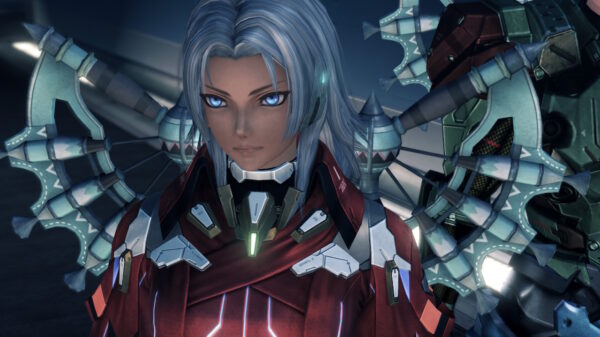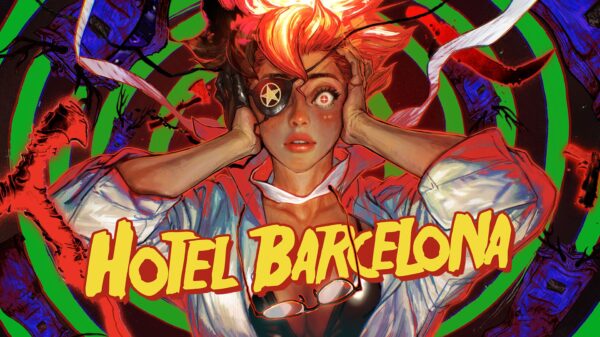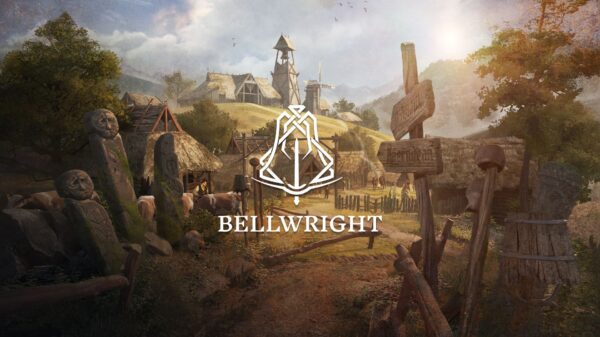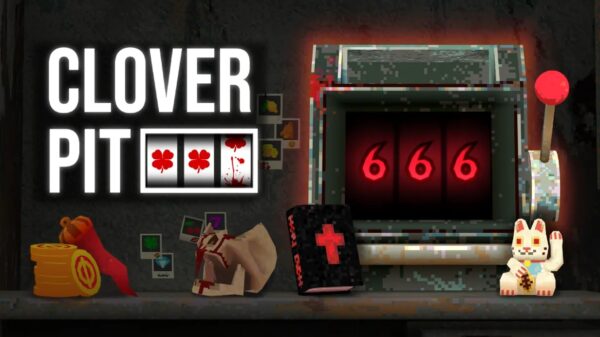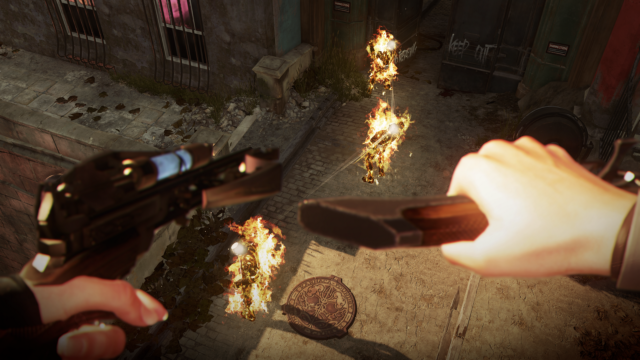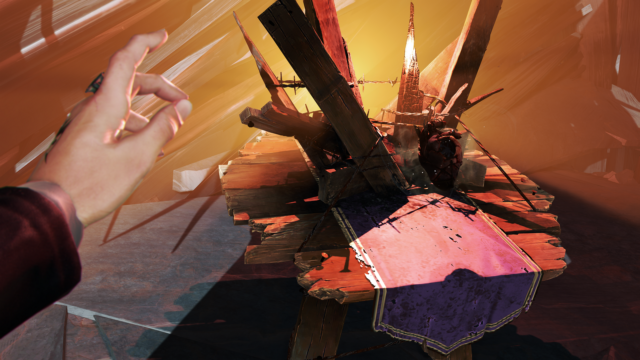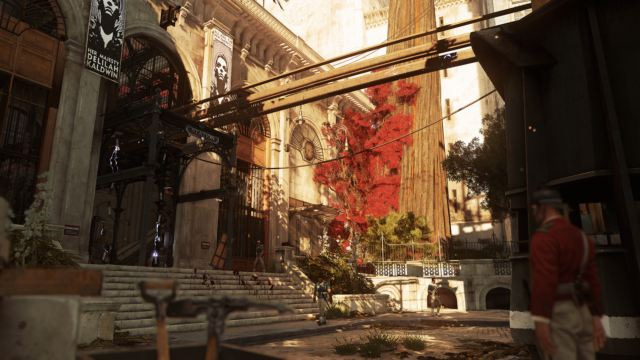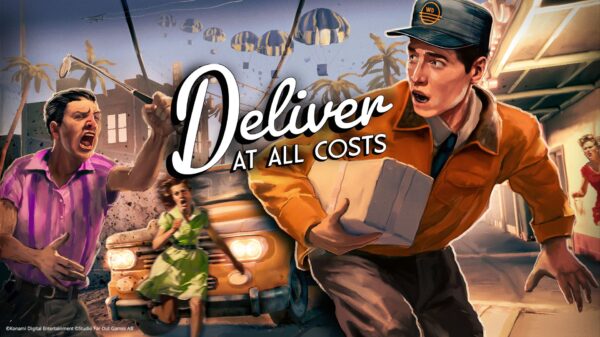Going into Dishonored 2 I thought I could briefly escape the onslaught of election and political news. Don’t get me wrong, I’m a news junkie, but everyone deserves a break, especially after the recent election season. In a lot of ways Dishonored 2 provided that escape with its incredible gameplay and intricate level design. But I didn’t expect its story to put the dynamics of leadership and class division at the forefront of my thoughts. Dishonored 2’s politically charged story was a nice surprise, but for those who don’t care about that stuff, the game side of it is really fun to play.
Dishonored 2
Developer: Arkane Studios
Price: $59.99
Platforms: PlayStation 4, Xbox One, PC
MonsterVine was supplied with PlayStation 4 code for review.
Dishonored 2’s story picks up 15 years after its predecessor. Emily Kaldwin reigns as empress in Dunwall, the setting of the first game. In that time, Emily has done little to better the quality of life over those she rules. It’s not her intent to do little as she explains throughout the game, but it’s her ignorance of the problems afflicting people outside of her circle of upper class elites. That class division sets up a coup led by the Duke of Serkanos, and Emily’s supposed aunt, Delilah Copperspoon. Emily (or Corvo depending on who you want to play as from the start of the game) is forced to see the world from the perspective of people struggling to survive on the streets of Karnaca, the setting of Dishonored 2.
Without breaking down every story beat, I was a bit disappointed by its abrupt ending. It was at odds with some of the rhetoric explored in the rest of the game. I did commit myself to a low Chaos playthrough which meant I would get a positive end. But that shouldn’t be an excuse to shy away from the game’s exploration into class division and politics. It instead created a dissonance between the impact of my choices and the narrative the writers were trying to employ.
Where Dishonored 2 doesn’t falter is in its gameplay and level design. At the start of each level, Emily or Corvo is given an objective with a general idea of how to succeed in eliminating their targets. It’s up to you to discover how flexible each level is. I was continually amazed by how large the environments felt after prodding the edges for alternate paths. In fact it changed my perception of each level, giving me a chance to rethink my tactics. In one instance I was tasked with killing one of two gang leaders to earn the trust of the victim’s rival to gain access into a mansion. After rummaging around a few notes I found (there are a ton of notes to read throughout the game) I discovered I could knock out each leader and have them sent to a prison as part of a larger ploy separate from Emily and Corvo’s mission. It was a solution I had to discover on my own without the game explicitly spelling it out for me. It’s a testament not only to Dishonored 2’s world building, but its environmental storytelling as well.
Throughout my play through as Emily I felt encouraged to explore and experiment all of the mechanics at work. For starters, Emily’s abilities are different than Corvo’s, with the former introducing returning players with new skills to play with. Emily’s Domino ability allows her to link up to four enemies. Once linked up, anything Emily does to one enemy, like shooting him or her with a sleep dart, will cause the others to suffer the same fate. It allowed me to dispatch large groups of enemies without giving myself away. There was also the Bloodflies, which replace the plagued rats from the first game. Early on I came across a glass case filled with the nasty bugs. After breaking it, the nearby guards were distracted with the new menace as I slipped away undetected. Dishonored 2 felt like it was constantly teaching me new ways to play with its mechanics and interact with the world as the game progressed. There’s even a time travel mechanic that shows up only once in the game that I immediately missed when it went away.
There are limits to Dishonored 2’s gameplay, and it comes in the form of an upgrade tree. In some cases I appreciated upgrading my abilities, but it caused me to miss out on a few skills that would’ve altered my approach to the objectives. Ability upgrades in Dishonored 2 are tied to runes scattered throughout the game. The more runes you find the more abilities you can unlock and upgrade. Eventually it created a wall between stealth and action styles of gameplay. As I put more points into Emily’s abilities for stealth, I neglected the attributes that would give her an edge in combat. The game provides some leeway for players that break out of a stealth run, but there were cases where I had to reload the game because I wasn’t strong enough for a combat situation. I understand the upgrade tree balanced the game and kept me from exploiting its mechanics, but it’s a frustrating way to stifle an otherwise flexible game.
Dishonored 2 left me with a desire for more levels and targets, but it also left me thinking about the world outside of the game. It may seem like a stretch to call a video game where you play as a magic wielding assassin to come out at the right time during the election season. But it did come out at the right time. It says a lot about the way leaders govern and the divisions it causes amongst large groups of people. There’s a balancing act when it comes to power and no matter what, it will tip people towards hope or cynicism. Dishonored 2’s Chaos meter is maybe an appropriate way to look at our own society.
 The Final Word
The Final Word
Dishonored 2 doesn’t fall short when it comes to giving players a flexible experience. It’s fun and has something to say about its world and its characters. It has its problems and they are annoying, but I thoroughly enjoyed by time in Dishonored 2
– MonsterVine Review Score: 4 out of 5 – Good

